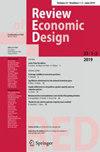南洋理工大学破产问题:一致性及相关调整原则
IF 0.5
4区 经济学
Q4 ECONOMICS
引用次数: 8
摘要
本文从一致性和争议衣原则的推广出发,对具有不可转让效用的破产问题进行了公理性的研究。一方面,我们讨论了几个一致性概念,并引入了包含比例规则、约束相对相等奖励规则和约束相对相等损失规则的参数破产规则类。另一方面,我们引入了调整破产规则的类别,并利用截断不变性、最小权利优先和相对对称的弱形式刻画了相对调整原则。本文章由计算机程序翻译,如有差异,请以英文原文为准。
NTU-bankruptcy problems: consistency and the relative adjustment principle
This paper axiomatically studies bankruptcy problems with nontransferable utility by focusing on generalizations of consistency and the contested garment principle. On the one hand, we discuss several consistency notions and introduce the class of parametric bankruptcy rules which contains the proportional rule, the constrained relative equal awards rule, and the constrained relative equal losses rule. On the other hand, we introduce the class of adjusted bankruptcy rules and characterize the relative adjustment principle by truncation invariance, minimal rights first, and a weak form of relative symmetry.
求助全文
通过发布文献求助,成功后即可免费获取论文全文。
去求助
来源期刊

Review of Economic Design
ECONOMICS-
CiteScore
0.80
自引率
28.60%
发文量
37
期刊介绍:
Review of Economic Design comprises the creative art and science of inventing, analyzing and testing economic as well as social and political institutions and mechanisms aimed at achieving individual objectives and social goals. In this age of Economic Design, the accumulated traditions and wealth of knowledge in normative and positive economics and the strategic analysis of game theory are applied with novel ideas in the creative tasks of designing and assembling diverse legal-economic instruments. These include constitutions and other assignments of rights, mechanisms for allocation or regulation, tax and incentive schemes, contract forms, voting and other choice aggregation procedures, markets, auctions, organizational forms, such as partnerships, together with supporting membership and other property rights, and information systems. These designs, the methods of analysis used in their scrutiny, as well as the mathematical techniques and empirical knowledge they employ, along with comparative assessments of the performance of known economic systems and implemented designs, all of these form natural components of the subject matter of Economic Design.
Officially cited as: Rev Econ Design
 求助内容:
求助内容: 应助结果提醒方式:
应助结果提醒方式:


